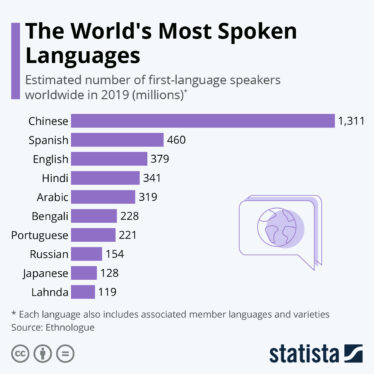Share of streaming among the top 10,000 tracks measured by Luminate in its recently-released 2023 Year End Music Report went down by 3.8 percentage points since 2021. Which begs the question: Where did that 3.8% go?
It went fully into the streaming share of Spanish language tracks, which went up by 3.8%.
Indeed, today, Spanish is the second most consumed language in music, both in the U.S. and globally.
In the United States, the top three languages in music consumption by percentage of the total are, of course, English (88.8%), followed by Spanish (8.1%) and Korean in a distant third (0.7%).
The most recent numbers show Spanish language music’s market share among the country’s most popular songs almost doubled over the past two years — jumping from 4.2% of the top 10,000 tracks in 2021 to 8.1% in 2023. Overall, consumption of Latin music in the U.S grew by 19.4 billion on-demand audio streams in 2023, a 24.1% jump. In total number of streams, it was second in growth only to country, which grew by 20.4 billion streams.
Worldwide, English-language music consumption among the 10,000 most listened to tracks fell substantially in 2023, from 67% in 2021 to 54.9% in 2023. Spanish-language music consumption also dipped, from 12.4% in 2021 to 10.1% in 2023, while consumption of music in Hindi grew from 6.1% to 7.8%, and in Japanese from 1.3% to 2.1%. However, all told, Spanish is still the second most listened to music language in the world, according to the study.
In the U.S., Spanish-language music’s growth has been a very gradual process that’s come with the growth of streaming, a bigger Latin population, and with a major cultural shift that accepts that there are more cultures and languages that can coexist. Chief among them is Spanish, which benefits from being the lingua franca of an entire continent, plus Spain. While Latins are not monolithic, as many have long pointed out, they are all (with the exception of Brazilians) united by language; go to any Latin music concert in the U.S., and you’ll find a plethora of nations gathered under the same roof enjoying the same music, regardless of its origin.
The shift in consumption has been noticed by mainstream labels; 25 years ago, Latin acts like Shakira and Ricky Martin, had to record in English to garner widespread promotion. Spanish, the language which has long defined “Latin” music, was conversely, widely seen as stepping stone on the path to international superstardom but not as the goal.
Today, for the first time, mainstream labels are signing and developing artists who record solely, or almost solely in Spanish, such as Yahrtiza y su Esencia to Columbia Records and Xavi to Interscope.
There is strength in numbers, and those numbers opened the door for Latin artists to scale the charts by singing only in Spanish, as well as for predominantly Spanish-language series –like “Narcos” and the new “Griselda”—to score big viewing numbers despite what many would have perceived as a language barrier years ago.
But clearly, today there is a growing number of non-Spanish speakers who also listen to music in Spanish. According to recent consumer research insights from Luminate, for example, 25% of U.S. music listeners (ages 13+) said they engage with Spanish-language music, even though Hispanics account for 19% of the population.
People may not speak Spanish, but they’re definitely listening to the music.
https://www.billboard.com/pro/spanish-language-music-consumption-data-latin-luminate-analysis/




